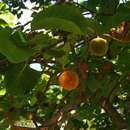Comprehensive Description
provided by Smithsonian Contributions to Botany
Nauclea diderichii (DeWildeman & Durand) Merrill
Standard trade name: Opepe
Local names: Jusia (Ghana and Ivory Coast), Bilinga (Cameroons)
Large trees abundant in wet places in evergreen and deciduous forests in Liberia, Ivory Coast, Ghana, South Nigeria, British Cameroons, Vbdngi-Shari, Gabon, Congo, Uganda, and Mozambique. The unbuttressed trunks attain a height of 120 ft and a girth of 9 ft, with yellowish rough bark having loose, papery scales; slash exudes a yellowish to brown sap that becomes sticky. Twigs are black, speckled.
The large (9–12 × 5–7 in), shining leaves are elliptic, acute at the ends, keeled towards the base, and stipulate. They are mostly deciduous except at the ends of shoots, and the nodes are often occupied by ants (Kennedy, 1936:216).
The small, white flowers are hairy inside and appear from February to June in small, globose, terminal heads. The fruit is yellow, fleshy, in a globose head deeply pitted between the deeply fused calyx lobes. The fruit dries hard, with embedded seeds, and is eaten in times of scarcity.
GENERAL DESCRIPTION.—The sapwood is white, the heartwood golden yellow, darkening later. It is hard, moderately heavy, average weight being about 46 lb/ft3 seasoned, and about 70 lb/ft3 when green. The grain is usually interlocked or irregular. The texture is fairly open, owing to rather large pores.
SEASONING.—With quarter-sawn material, seasoning appears to be fairly quick with little degrade, but flat-sawn timber is apt to prove refractory (FPRL, 1956). British Forest Products Laboratory kiln schedule E is recommended.
DURABILITY.—Opepe is very durable. It is moderately resistant to preservative treatment. The sapwood is, however, permeable.
WORKING QUALITIES.—The wood works well, has a lustrous surface, and takes a good polish; it has a tendency to split when nailed but takes screws fairly well. The timber can be glued satisfactorily.
USES.—It is eminently suitable for harbor work such as piles, fenders, and wallings because of its resistance to marine borers. It is used for heavy structural work, planking, railway wagon bottoms, railway cross-ties, and also as telegraph cross-arms. Opepe is also used for fufu mortars (in Ghana), canoes, and for making charcoal. In French Equatorial Africa the boiled, steeped bark is used to treat gonorrhea and stomach complaints. Leaves are used for fevers and diarrhea. Workers with the wood have suffered, sometimes fatally, from a wood alkaloid said to be a cumulative cardiac poison (Henry, 1949:665).
XYLEM ANATOMY.—No annual rings. Wood diffuse-porous. Vessels solitary, oval, none angular; average pore diameter 100μm, range 150μm–210μm; average vessel element length 711μm, range 375μm–1000μm; vessel wall thickness ca. 6.25μm; perforation plates mostly inclined about 10° to 20°, some transverse, simple perforations; intervascular pits very small, bordered with slitted apertures, alternate. Imperforate tracheary elements: no septate fibers evident; many fibers with few or no pits, others with numerous bordered pits in a single rank. Vascular rays: mostly heterogeneous and heterocellular; 1 to 3 seriate cells, 3 to 37 cells high; many with long “tails”; no fusiform rays. Axial parenchyma: apotracheal, scanty, in short or broken tangential chains.
Only in the lack of angular vessels and in the simple, mostly transverse perforation plates does this wood show advanced characters. In other respects it is primitive.
- bibliographic citation
- Ayensu, Edward S. and Bentum, Albert. 1974. "Commercial Timbers of West Africa." Smithsonian Contributions to Botany. 1-69. https://doi.org/10.5479/si.0081024X.14
Nauclea: Brief Summary
provided by wikipedia EN
Nauclea is a genus of flowering plants in the family Rubiaceae. The species are evergreen trees or shrubs that are native to the paleotropics. The terminal vegetative buds are usually strongly flattened. The generic name is derived from the Ancient Greek words naus, meaning "ship" and kleio, meaning "to close". It refers to the resemblance of the cells of the capsule to a ship's hull.
- license
- cc-by-sa-3.0
- copyright
- Wikipedia authors and editors

